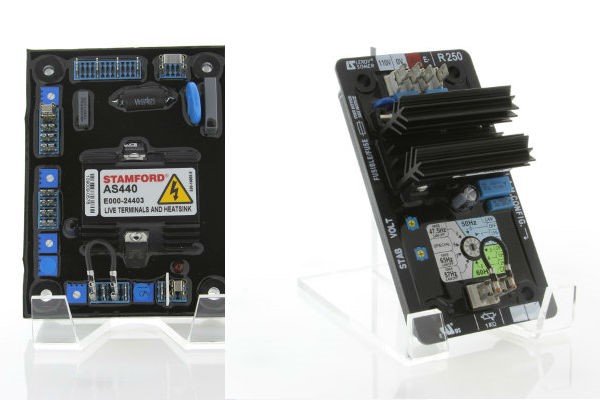How an Automatic Voltage Regulator Can Protect Your Genset

Power outages appear to be a common occurrence these days. How frequently do they happen? According to a 2018 report by S&C Electric Company, 21% of all businesses across the United States encounter a power outage at least once a month. Losses and unplanned costs from even short-term disruptions damage a company’s bottom line.
However, a standby source of power such as a generator will ensure no lapse in electricity and help prevent this ruin. Durable and designed to withstand the elements, a genset will last about 15-20 years.
With regular maintenance and the addition of an automatic voltage regulator (AVR), you can keep your generator in optimal condition and extend its lifespan.
To help you understand how crucial an AVR is to your genset, let’s take a closer look at its various types and how to use an automatic voltage regulator.
Contents:
- What is an Automatic Voltage Regulator
- How to Use an Automatic Voltage Regulator
- Damage and Downtime
- Find Out More About Automatic Voltage Regulators
What is an Automatic Voltage Regulator?
The automatic voltage regulator is a device used in a genset (an engine and a generator/alternator mounted together along with associated controls to create a single piece of equipment) to adjust a fluctuating voltage level to a constant level. AVRs vary in size, design, name and description.
Types of automatic voltage regulators
There are three types of automatic voltage regulators; ferroresonant, mechanical and electronic.
Ferroresonant
Invented in 1938, the ferroresonant automatic voltage regulator is the oldest of the three AVR types. Due to its limited use for single-phase applications, which is typical of residential power systems, and its low range of 50%-80% efficiency rates, the ferroresonant is being replaced by electronic voltage regulators.
Mechanical
Also aged more than 50 years is the mechanical voltage regulator. While the other two types are often referred to by a few different names, the mechanical AVR has a multitude, many of which indicate their purpose:
- Line voltage regulator
- Electromechanical voltage regulator
- Step voltage regulator
- Auto-boost regulator
The mechanical automatic voltage regulator is the most popular for power quality applications in markets outside the United States. Akin to the ferroresonant AVR, this type is being moved out by the electronic voltage regulator.
Electronic
The youngest AVR in the group is the electronic type of voltage regulator and has become the modern standard in most power quality applications. Its evolution has resulted from the advancements in power semiconductors over the last few decades. The speed and performance advantages of the electronic AVR over ferroresonant and mechanical options make it an ideal choice for electronics in industrial and commercial applications.
Although the electronic automatic voltage regulator is more expensive than the mechanical AVR, it has several advantages:
- Reliable line isolation
- Immediate voltage correction speed
- Requires little regular maintenance
How to Use an Automatic Voltage Regulator
The primary function of an AVR is to prevent downtime and damage to your equipment caused by poor voltage levels from transient activity like power spikes and surges.
Spikes
Spikes are momentary electrical disruptions from an increase in voltage that lasts less than three nanoseconds. Although categorized as an over-voltage, they are often undetectable and are not likely to cause harm to electronic devices. Spikes have numerous sources such as:
- Normal utility operations
- Static electricity
- Arcing (faulty contacts in breakers, switches and contactors)
Surges
Surges, on the other hand, are an over-voltage that persist longer than spikes and can damage, degrade, or destroy electronic equipment. Similar to spikes, surges have a multitude of causes. A common source generated inside a building are devices that switch power on and off, e.g., a thermostat. NEMA Surge Protection Institute reports that 60-80% of surges are created within a facility.
Sources responsible for surges outside of a building include utility-initiated grid, capacitor bank switching, and lightning. It is important to note that lightning does not need to make direct contact to be destructive to electronic devices.
Damage and Downtime
Without an automatic voltage regulator, the effects of inconsistent voltage levels on your equipment will be apparent. If the voltage is too high, it can cause overheating and premature failure of electrical and electronic parts. Damage from overheating is cumulative and permanent. Regular occurrences of mild overheating can cause an equal amount of component damage as a few experiences of severe overheating.
The absence of an AVR can further prove problematic if your business suffers downtime. Data from an E Source survey notes that power outages result in over $27 billion in losses for US businesses.
In addition to the financial consequences, other impacted areas may include:
- Delivery systems
- Customer satisfaction
- Safety or environmental
- Employee morale
Find Out More About Automatic Voltage Regulators
If you have invested in a high-quality genset to safeguard your home or business, don’t forget to protect the generator system itself with an automatic voltage regulator. General Power offers AVRs from several companies, including Stamford, Leroy Somer, Basler, Marathon, Marelli, Mecc Alte, Delco and more.
Contact our team to order an automatic voltage regulator for your genset now.

